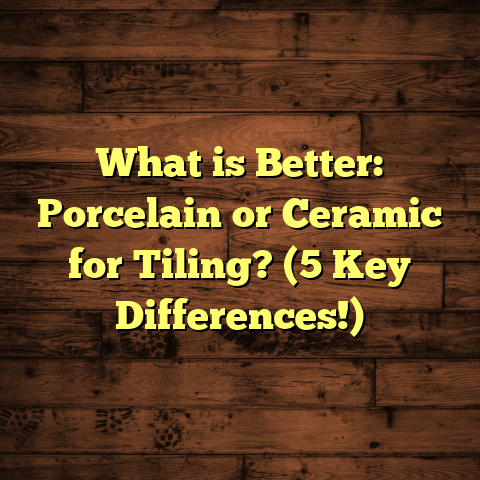What Is Wood Laminate Flooring? (5 Benefits to Know Now!)
I remember the first time I came across wood laminate flooring—it felt like stumbling upon a clever secret in the flooring world. The surface looked just like real wood, with those rich grains and warm tones that immediately grab attention, yet it wasn’t quite the same. It was as if someone had taken the natural beauty of hardwood and wrapped it in a more practical, modern package. For me, this discovery was eye-opening because I had worked extensively with hardwood floors before, and seeing an affordable alternative that didn’t sacrifice style was a game changer.
Over the years, I’ve installed laminate floors in all kinds of homes—from busy family kitchens to sleek urban apartments—and each experience has taught me something new. The combination of durability, ease of installation, and that almost uncanny wood look keeps bringing me back to laminate as a solid option for many homeowners.
What Is Wood Laminate Flooring?
Wood laminate flooring is a synthetic flooring product designed to imitate the appearance of natural hardwood floors. At its core, it’s a layered composite material made through a lamination process—hence the name “laminate.” Unlike hardwood, which is solid or engineered wood planks cut from actual trees, laminate uses a photographic layer to replicate wood textures and colors.
Let me break down the layers that make up laminate flooring:
- Wear Layer: This is the topmost transparent layer made from tough melamine resin or aluminum oxide. It protects the floor from scratches, stains, fading, and moisture damage.
- Decorative Layer: Directly below the wear layer is a high-resolution photographic image of wood grain. This is what gives laminate its realistic wood look—with all the knots, colors, and finishes you’d expect in hardwood.
- Core Layer: The heart of the laminate plank is typically high-density fiberboard (HDF). This fiberboard is compressed wood fibers bonded with resins to provide strength and stability.
- Backing Layer: The bottom layer adds moisture resistance and structural support, helping prevent warping or bending.
This multi-layer construction allows laminate flooring to combine visual appeal with resilience. The process of fusing these layers together through heat and pressure creates a durable plank that looks like wood but can stand up better to everyday wear and tear.
How Laminate Differs From Real Hardwood
I often get asked by clients about the difference between laminate and real hardwood flooring. Here’s what I usually explain:
- Material: Hardwood is solid wood or engineered wood planks made from real trees. Laminate uses a photographic image on fiberboard.
- Installation: Hardwood usually requires nails or glue and sometimes sanding and finishing on-site. Laminate often uses click-lock planks that float above the subfloor.
- Durability: Laminate has a tough top layer resistant to scratches and stains; hardwood can dent or scratch more easily but can be refinished multiple times.
- Cost: Laminate tends to be more affordable per square foot than hardwood.
- Lifespan: Hardwood floors can last decades or even centuries with proper care. Laminate typically lasts 10-20 years depending on quality.
When I started working with laminate over a decade ago, technology was less advanced. The photographic layers looked somewhat artificial, and some laminates were prone to chipping or warping. But modern laminates have come a long way—manufacturers now use embossed textures to mimic real wood grain patterns, making it almost impossible for most people to tell the difference at a glance.
Personal Story: My First Laminate Installation
I still remember my first full laminate installation job—a small condo in a bustling city center. The client wanted the warmth of oak floors but had a tight budget and limited time for renovations. I suggested laminate as a solution.
Preparing the subfloor took some extra effort because older concrete had some uneven spots. Once that was addressed, the installation of click-lock planks went surprisingly smooth. By the end of two days, the entire living area gleamed with what looked like freshly installed hardwood but without the usual fuss or cost.
The client was thrilled. Months later, she called me to say how easy it was to keep clean despite her two toddlers running around—a testament to laminate’s practical benefits beyond aesthetics.
Five Benefits of Wood Laminate Flooring You Should Know
If you’re weighing your options for new floors, it helps to understand why laminate has become so popular. Here are five key benefits I’ve seen repeatedly in my work and research.
1. Affordable Price Point Without Sacrificing Style
One of laminate’s biggest selling points is cost-effectiveness. Hardwood floors are undeniably beautiful but can be expensive both for materials and installation. Depending on species and grade, hardwood can run anywhere from $8 to $15+ per square foot just for materials—installation adds another $3-$8 per square foot on average.
Laminate flooring usually costs between $2 to $5 per square foot for materials alone, with installation often costing less due to quicker labor times and simpler methods like floating floors.
In my experience, this price difference means many homeowners can afford to cover larger spaces or choose higher-end styles without breaking the bank. For instance, I helped a client install 800 square feet of laminate in their entire upstairs for about what one room of hardwood would have cost.
Industry data supports this affordability trend: A 2023 report from the National Wood Flooring Association showed that laminate accounts for roughly 25% of residential flooring sales in the U.S.—largely driven by its competitive pricing.
2. Durability That Fits Busy Lives
I’ve installed laminate floors in homes filled with kids, pets, and constant activity—and they hold up well under pressure. The wear layer on quality laminates protects against everyday scratches from shoes, furniture movement, toys, and even pet claws better than many finished hardwood floors.
One family I worked with had two young children who loved painting and crafting on the floor—usually a recipe for disaster on hardwood. But their laminate floors came through with minimal damage after years of spills and messes.
Manufacturers back this durability with warranties from 10 up to 30 years for residential wear resistance. While no floor is completely indestructible, laminate’s protective layer helps maintain appearance longer without refinishing.
3. Variety of Styles That Match Every Taste
I’m always impressed by how many design options laminate offers today. Because the surface is a photographic image rather than real wood veneer, manufacturers can reproduce nearly every wood species imaginable—from classic oak and cherry to exotic teak or hickory—all in various stains and textures.
If you have a specific style or color in mind, there’s probably a laminate that fits it—and often at less cost than sourcing that exact hardwood.
For example, I once worked on a mid-century modern home where the owners wanted whitewashed ash floors—a rare and costly option in solid wood locally. Laminate delivered an excellent match at a fraction of the price.
Laminate also comes in different plank sizes—from narrow strips replicating traditional hardwood boards to wider planks imitating contemporary trends. Some even feature hand-scraped or distressed looks for added character.
4. Simple Cleaning and Maintenance
I know many people don’t want to spend hours fussing over their floors, so laminate’s low-maintenance nature is a big plus. Regular sweeping or vacuuming combined with occasional damp mopping usually keeps it looking fresh.
Unlike hardwood, there’s no need for waxing, polishing, or refinishing every few years. Stains from wine spills or pet accidents wipe away easily thanks to the sealed surface.
Still, I always advise clients to avoid excessive water when mopping since standing moisture can seep into seams and cause swelling over time. Using microfiber mops lightly dampened works best in my experience.
5. Faster Installation Saves Time and Hassle
One reason I appreciate laminate is how quickly it goes down compared to hardwood floors that require nailing/gluing plus sanding and finishing.
Most laminates use click-lock systems allowing planks to snap together tightly without glue or nails—floating above the subfloor rather than being directly attached.
This means less mess during installation and shorter project timelines—usually one or two days for an average room vs. several days or weeks with hardwood finishes.
From my personal projects, I’ve completed living room installations in just one day where hardwood would have taken at least three days including drying time between coats.
Challenges I’ve Encountered (And What You Should Know)
While I’m generally pro-laminate based on my experience and research, I want to be upfront about some downsides so you go in prepared.
Moisture Issues Can Be Tricky
Despite advances in water-resistant laminates, moisture remains laminate’s biggest enemy. If installed where humidity is high—like basements or bathrooms—or if spills aren’t cleaned promptly, floors can swell or warp.
I had one job where water leaked under the floor due to plumbing issues; the laminate buckled badly despite manufacturer claims of water resistance.
To avoid this fate:
- Use proper vapor barriers under laminate in moisture-prone areas.
- Select products specifically rated for wet areas if needed.
- Clean spills quickly.
- Consider alternative materials like luxury vinyl planks (LVP) for bathrooms or basements if moisture risks are high.
Not Refinishable Like Hardwood
Unlike solid wood floors that can be sanded and refinished multiple times over decades (sometimes centuries), damage to laminate is permanent once the wear layer is compromised.
If you get deep scratches or chips, you usually need to replace entire planks or sections rather than repairing them easily.
This means laminate might not be ideal if you want an heirloom floor designed to last generations with refinishing options.
Sound and Feel Differences
Some homeowners notice laminate feels less “warm” or authentic underfoot compared to hardwood’s natural texture.
Laminate can also produce hollow sounds when walked on unless properly installed with quality underlayment designed for sound absorption.
In my installations, I always recommend foam or cork underlayments; they improve comfort and reduce noise significantly but add slightly to cost.
Environmental Concerns
While laminate isn’t made from solid wood logs requiring tree harvesting like hardwood does, there are questions about sustainability because it uses synthetic resins and adhesives derived from petrochemicals.
Also, disposal can be tricky since laminated boards aren’t biodegradable like natural wood.
If environmental impact is important for you, look for brands offering certifications such as FloorScore (indoor air quality) or products made with recycled content.
How FloorTally Has Helped Me With Cost Estimates
Over years managing flooring projects, both large and small, one aspect that often slows things down is figuring out accurate budgets early on.
That’s where tools like FloorTally come into play.
FloorTally allows me to input room dimensions quickly along with material choices (laminate styles included), labor rates based on local averages, waste factors (extra material needed for cuts), and even underlayment costs.
The tool then spits out detailed estimates that help me communicate realistic budgets with clients before we start work—avoiding surprises mid-project that cause stress or delays.
For example:
- When working on a 500-square-foot family room renovation with mid-range laminate,
- FloorTally helped me factor in $3 per square foot material,
- $1.50 labor,
- plus 10% waste,
- resulting in an estimate close enough that we stuck to it without major adjustments after ordering supplies.
This efficiency lets me focus energy on design choices and installation quality rather than crunching numbers manually every time.
Deep Dive: Case Study Highlighting Laminate Flooring in Action
Let me share one project where I installed wood-look laminate across multiple rooms in an older home undergoing modernization.
Project Background:
The clients wanted oak-style floors throughout living areas but had budget limits ruling out real hardwood across all rooms. They also had two kids and a dog—so durability was paramount.
Material Choice:
We selected a high-end laminate with embossed texture mimicking oak grain closely plus enhanced wear layer rated for heavy traffic environments.
Installation Notes:
Subfloor prep was extensive since original floors were uneven concrete slabs prone to moisture intrusion. We laid vapor barriers plus thick cork underlayment for comfort and soundproofing before floating laminate planks over top.
Outcome:
The floors looked fantastic immediately after installation—matching their vision perfectly—and held up impressively after one year despite daily activity with kids playing indoors constantly.
The wear layer showed no scratches; cleaning was easy; no moisture issues emerged thanks to proper preparation; sound reduction was noticeable compared to previous bare concrete floor below carpet.
Overall satisfaction was high—proving how carefully chosen laminate flooring combined with best practice installation delivers great results even in challenging conditions.
More Insights: Data & Trends About Laminate Flooring
To give you some more perspective:
- A 2023 industry survey reported that around 40% of homeowners selecting new flooring favored laminates for their balance of cost/performance.
- Waterproof laminates now make up approximately 30% of all laminates sold—a testament to growing demand for moisture resistance.
- Average lifespan ranges from 10-20 years depending on brand quality—with warranties extending beyond 20 years becoming more common among premium lines.
- DIY installations account for nearly 50% of all laminate floor projects due to straightforward click-lock systems.
- Environmental certifications are increasingly sought by eco-conscious buyers; check labels like GREENGUARD if indoor air quality matters most.
Tips From My Experience: Choosing & Caring For Laminate Floors
Since you might be considering laminate yourself, here are some practical tips I’ve learned over time:
Choosing Laminate Flooring:
- Look beyond price: Higher-end laminates usually offer thicker wear layers (12 mils or more) which translates into better durability.
- Check manufacturer warranties carefully—longer warranty often signals higher quality.
- Match your lifestyle: If pets/kids are active at home, pick abrasion-resistant ratings (AC3 or above).
- Review moisture ratings if installing near kitchens or basements.
- Don’t forget underlayment—investing here pays off in comfort & noise reduction.
Installing Laminate Flooring:
- Prepare subfloor meticulously—levelness is crucial.
- Use vapor barriers where moisture might be present.
- Leave expansion gaps around walls as recommended by manufacturer.
- Acclimate planks in your home environment before installation (usually 48 hours).
- Follow instructions carefully with click-lock systems for tight seams without gaps.
Caring For Laminate Floors:
- Sweep/vacuum regularly to remove grit.
- Mop with lightly dampened microfiber cloths only.
- Clean spills promptly.
- Avoid abrasive cleaners or waxes designed for hardwood.
- Use furniture pads under legs to prevent scratching.
- Replace damaged planks promptly if needed (some brands offer DIY repair kits).
Final Thoughts From My Flooring Journey
Over many years installing flooring across diverse homes and styles, wood laminate has proven itself as a smart compromise between beauty, durability, cost, and ease of maintenance. It’s not perfect—there are limits around moisture sensitivity and lifespan—but for many homeowners it strikes just the right balance.
If you want floors that look great without emptying your wallet or waiting weeks for installation, laminate deserves serious consideration. And from my perspective as someone who’s seen results firsthand multiple times over—it’s often exactly what clients need when upgrading living rooms, kitchens, hallways, or even bedrooms.
Got questions about picking styles? Curious about installation tricks? Or wondering about how your space might handle laminate? Just ask—I’m happy to share what I know from decades working hands-on with these floors!
Would you like me to include specifics about brands I prefer? Or maybe break down step-by-step how I handle tricky subfloor preps? Let me know!





